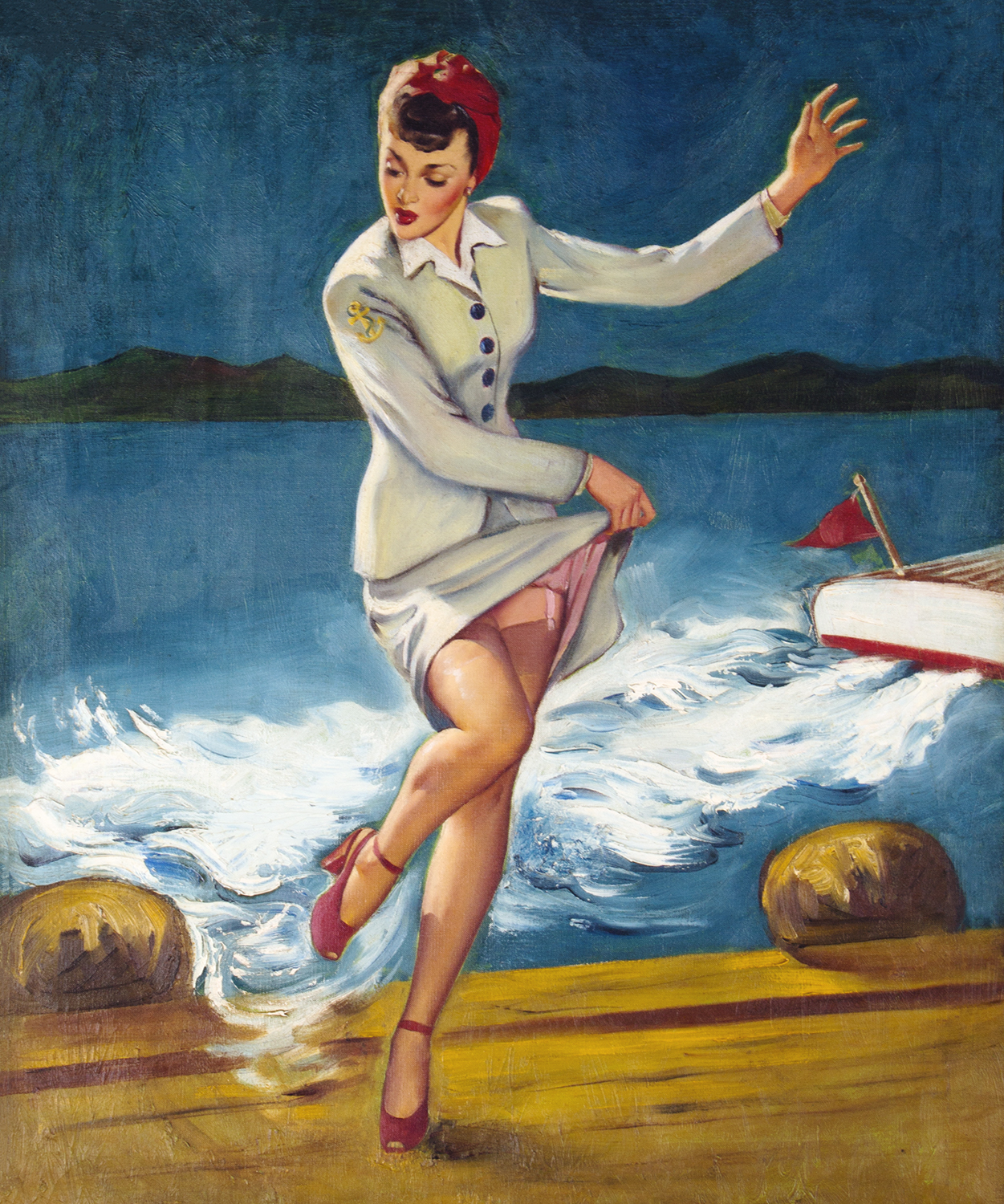

What a Break, overpainted artwork by Gil Elvgren
This is a newly unearthed, rare surviving Gil Elvgren painting that was created for the Louis F. Dow calendar line of 1944 and originally marketed under the title “What a Break”. As was the case with many of the canvases Elvgren completed for Dow, this piece was overpainted for a second use. The face and figure remain from the original pose of “What a Break” but the outfit and background have been reimagined to show this cheesecake “oops” scene as one of a sailor girl precariously perched on a boating dock.
It was common for the calendar companies that commissioned artwork to retain ownership of the original canvases as well as the copyrights. So when Elvgren left Louis F. Dow for rival calendar company Brown & Bigelow in 1944, Dow was determined to erase Elvgren’s original works while still profiting off of them. They employed artist Vaughan Bass to overpaint these canvases so they could be marketed a second time. Bass was told to leave the faces untouched, but to extensively re-work the backgrounds and fashions. Dow would go on to re-title these images, and publish them as mailers, calendars, advertisements, and mutoscope art.

About the artist: Gil Elvgren
Gillete Elvgren is regarded today as the most technically proficient and gifted commercial pin-up artist of the 20th century, a prolific and hard working perfectionist who created luminous portraits of the mischievous girl next door for the Louis F. Dow Calendar Company and later the Brown & Bigelow Calendar Company.
Elvgren worked as a commercial illustrator for many of the slick magazine publications, studying under his mentor Haddon Sundblom, and developed an accomplished and technically superior style with great commercial appeal, perfectly capturing the look and feel of post war America. His advertising accounts included Coca- Cola, Sylvania, Orange Crush, Schlitz Beer, General Electric, and Napa Auto Parts.
Gil Elvgren’s ability to capture the spirit and sensuality of American feminine beauty was unsurpassed. His pin-ups were pictures of real girls in real, everyday situations. Sometimes they were a bit exaggerated, but they always worked.
When Elvgren was once asked what feature of a model most interested him, he replied, “A gal with highly mobile facial features capable of a wide range of expressions is the real jewel. The face is the personality.” The model was the all-important factor in making a painting strong. He preferred young models (15 to 20 years old) just starting their careers, and valued models who were enthusiastic and interested in the project, though he said that they were very hard to find.
When asked about his techniques, he explained the distinctive “touches” he added to every painting how he built up the bust, lengthened the legs, pinched in the waist, gave the body more hyper-defined curves, worked over the facial features and expression, added just a little more of a tip and tilt to the nose, made the mouth fuller and the eyes a bit larger. He ended by saying that he liked to create the feeling that, underneath all the surface charms, there was a delicious warmth of mischief behind the model’s eyes.
The distinguishing mark of Elvgren’s pin-ups compared with those of his contemporaries is that the Elvgren Girls looked like real people. At any moment, the girl might step out of the painting and say good morning or good night or offer the viewer a cup of coffee, a drink, or an invitation.
Elvgren Girls had personality and zest; they were lively, friendly beauties brimming with enthusiasm. They were sweet-faced, but also generously endowed by nature. They could easily kindle a twinkle in anyone’s eye and often had one in their own. For more than thirty years, from the 1940s to the 1960s, they epitomized the American Girl.
Elvgren is the subject of several recent books and his painting “Anchors a Wow” serves as cover art for Taschen’s 1996 monograph “The Great American Pin-Up” by Charles Martignette and Louis Meisel.


